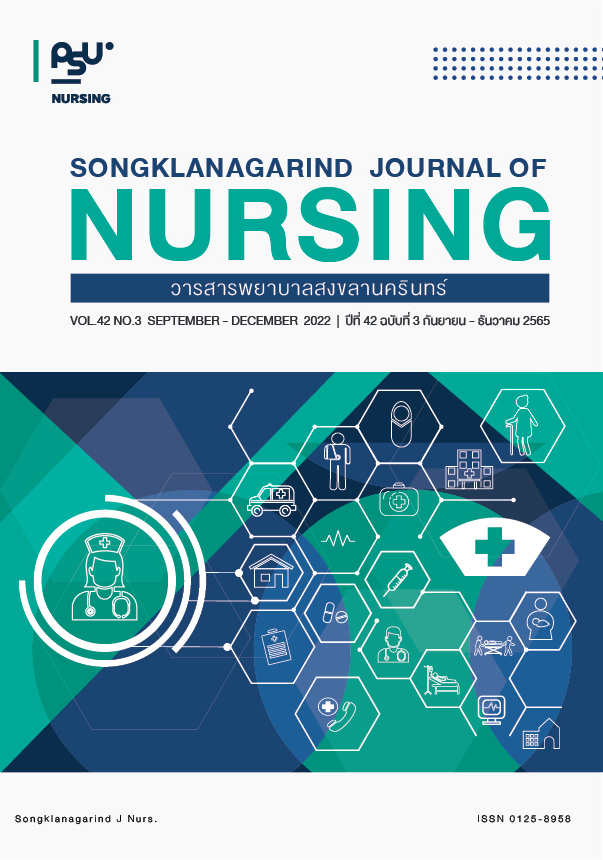การพัฒนารูปแบบการดูแลผู้ป่วยบาดเจ็บหลายระบบในห้องฉุกเฉิน โรงพยาบาลมหาราชนครศรีธรรมราช
Main Article Content
บทคัดย่อ
วัตถุประสงค์: การวิจัยและพัฒนานี้มีวัตถุประสงค์เพื่อพัฒนาและประเมินผลการใช้รูปแบบการดูแลผู้ป่วยบาดเจ็บหลายระบบในห้องฉุกเฉิน โรงพยาบาลมหาราชนครศรีธรรมราช วิธีการ: การวิจัยมี 3 ระยะคือ 1) การวิเคราะห์ปัญหาและสถานการณ์ 2) การพัฒนารูปแบบการดูแลผู้ป่วยบาดเจ็บหลายระบบ และ 3) การประเมินประสิทธิผลของการใช้รูปแบบการดูแลผู้ป่วยบาดเจ็บหลายระบบ กลุ่มตัวอย่าง คือ พยาบาลที่ดูแลผู้ป่วยบาดเจ็บหลายระบบ 33 คน และผู้ป่วยบาดเจ็บหลายระบบ 93 คน เครื่องมือเก็บข้อมูลประกอบด้วย 1) แบบบันทึกข้อมูลส่วนบุคคลและข้อมูลการเจ็บป่วยของผู้ป่วย 2) แบบบันทึกข้อมูลส่วนบุคคลของพยาบาลวิชาชีพ 3) แบบประเมินผลลัพธ์ด้านกระบวนการดูแล 4) แบบบันทึกผลลัพธ์ทางคลินิก และ 5) แบบประเมินผลลัพธ์ด้านองค์กร ผลการศึกษา: รูปแบบการดูแลผู้ป่วยบาดเจ็บหลายระบบในห้องฉุกเฉิน โรงพยาบาลมหาราชนครศรีธรรมราช ประกอบด้วย 1) รูปแบบการดูแลผู้ป่วยบาดเจ็บหลายระบบในห้องฉุกเฉิน และ 2) ทีมการพยาบาลผู้ป่วยบาดเจ็บหลายระบบ ผลการประเมินประสิทธิผลของการใช้รูปแบบการดูแลผู้ป่วยบาดเจ็บหลายระบบในห้องฉุกเฉิน พบว่า ความเป็นไปได้ของการนำรูปแบบการดูแลไปใช้และด้านความง่ายในทางปฏิบัติอยู่ในระดับมากและมากที่สุด (> ร้อยละ 80) และ ผลลัพธ์ทางคลินิกบรรลุเป้าหมายที่ตั้งไว้ทุกตัวชี้วัด สรุป: ผลการศึกษานี้แสดงให้เห็นว่ารูปแบบการดูแลผู้ป่วยบาดเจ็บหลายระบบที่พัฒนาขึ้นมีความเป็นไปได้ในการนำมาใช้จริง สามารถเพิ่มคุณภาพในการดูแลผู้ป่วยบาดเจ็บหลายระบบ ทั้งนี้ควรศึกษาติดตามระยะยาวเมื่อผู้ป่วยเข้ารักษาในโรงพยาบาล และสนับสนุนให้มีการใช้รูปแบบนี้ในโรงพยาบาลอื่นที่มีบริบทคล้ายคลึงต่อไป
Article Details

อนุญาตภายใต้เงื่อนไข Creative Commons Attribution-NonCommercial-NoDerivatives 4.0 International License.
เอกสารอ้างอิง
Emergency medicine and Forensic medicine department of Maharaj Nakhon Si Thammarat Hospital. Statistical data Fiscal year 2018. Nakhon Si Thammarat: Maharaj Nakhon Si Thammarat Hospital; 2018. Thai.
Emergency medicine and Forensic medicine department of Maharaj Nakhon Si Thammarat Hospital. Statistical data Fiscal year 2019. Nakhon Si Thammarat: Maharaj Nakhon Si Thammarat Hospital; 2019. Thai.
Emergency medicine and Forensic medicine department of Maharaj Nakhon Si Thammarat Hospital. Statistical data Fiscal year 2020. Nakhon Si Thammarat: Maharaj Nakhon Si Thammarat Hospital; 2020. Thai.
American College of Surgeons. ATLS® advanced trauma life support® student course manual. 10 th ed. Illinois: American College of Surgeons; 2018.
Frink M, Lechler P, Debus F, et al. Multiple trauma and emergency room management. Dtsch Arztebl Int. 2017; 114(29-30): 497-503. doi: 10.3238/arztebl.2017.0497.
Thanapaisal C, Wisanuyotin T, Tacha-a-tik P, editors. ER trauma care. 1 st ed. Khon Kaen: Klangnana Wittaya Printing; 2011. Thai.
Elbaih AH, Basyouni FH. Teaching approach of primary survey in trauma patients. Sun Text Rev Surg. 2020; 1(1): 101-7. doi: 10.51737/2766-4767.2020.001.
Aimaurai V. Nursing care for multiple trauma patients. HHSK. 2019; 4(1): e0051-64. Thai.
Saimai P, Norasan S, Unhasuta K, et al. Quality care of trauma patients at resuscitation unit in the university hospital. J Public Health. 2016; 46(3): 223-35. Thai.
Songwathana P. Continuing process in trauma care. pnujr. 2012; 4(2): 101-14. Thai.
Wang CJ, Yen ST, Huang SF, et al. Effective of trauma team on medical resource utilization and quality of care for patients with major trauma. BMC Health Serv Res. 2017; 17(505): 2-5. doi: 10.1186/s12913-017-2429-3.
Kanchanitanont C, Vipavakarn S, Prombutr R. The development of nursing care model for severe multiple injury in Krabi Hospital. JRTAN. 2019; 20(1): 339-50. Thai.
Hanucharurnkul S. Improvement sciences. TJNMP. 2016; 3(2): 5-14. Thai.
Boocha P, Seangduang N. Research and development: Process and application. JPPHD. 2021; 1(1): 77-89. Thai.
Pukkham K, Khuwatsamrit K, Wisettharn T. Evaluating the feasibility and clinical outcome for assessment prevention and management of acute delirium in a surgical intensive care unit. TJNMP. 2019; 6(1): 68-86. Thai.
Kidsree K. Core competencies of emergency room-nurses in Chiangkham Hospital, Phayao province. LPHJ. 2013; 9(3): 166-81. Thai.
Groenestege-Kreb DT, Maarseveen OV, Leenen L. Trauma team. Br J Anaesth. 2014; 113(2): 258-65. doi: 10.1093/bja/aeu236.
Pornchensuanpong C, Laor P, Boonchoo K. The development of an evidence based practice care model for traumatic injury patients in Nakhon Nayok Hospital. NJPH. 2016; 26(2): 89-102. Thai.
Kumkong M, Nawsuwan K. Guideline for developing quality and safety in caring for patients with accident and emergency. EAU Heritage Journal Science and Technology. 2017; 11(3): 30-42. Thai.
Dumrongchitti P, Srisanit R, Duangdee P. Development of nursing practice for major trauma patients in Chaophya Abhaibhubejhr Hospital. Journal of Public Health Nursing. 2016; 28(1): 43-54. Thai.
Lee KC, Lin TC, Chiang HF, et al. Predicting outcome after trauma prognostic model development base on admission features through machine learning. Medicine. 2021; 100(49): 1-7. doi: 10.1097/MD.0000000000027753.
Earnest A, Palmer C, O’Reilly G, et al. Development and validation of a risk adjustment model for mortality and hospital length of stay for trauma patients: A prospective registry-based study in Australia. BMJ Open. 2021; 11: 1-14. doi: 10.1136/bmjopen-2021-050795.
Yaowares P, Chayaput P, Peamsin S, et al. Influential factors of severity of injury, comorbidity, the number of surgeries and the number of complications on hospital length of stay in patients sustaining traumatic injury. Nurs Sci J Thai. 2020; 38(4): 91-103. Thai.
Thikhian N, Wittayachamnankul B, Tangsuwanaruk T, et al. Factors affecting the outcomes of severe traumatic brain injury patients undergoing emergency surgery. J Med Health Sci. 2021; 28(3): 1-16. Thai.
Yousefzadeh-Chabok S, Hosseinpour M, Kouchakinejad-Eramsadati L, et al. Comparison of revised trauma score, injury severity score and trauma and injury severity score for mortality prediction in elderly trauma patients. Ulus Travma Acil Cerrahi Derg. 2016; 22(6): 536-40. doi: 10.5505/tjtes.2016.93288.
Wutzler S, Maegele M, Wafaisade A, et al. Risk stratification in trauma and hemorrhage shock: Scoring system derived from trauma register DGU. Injury Int J Care Injured. 2014; 45S: S29-S34. doi: 10.1016/j.injury.2014.08.014.
Yuwadee N, Pudpong J, Wongwikkarn N, et al. The development of a case management model for patients with multiple trauma, Uthai Thani Hospital. JPMAT. 2019; 9(3): 280-95. Thai.


